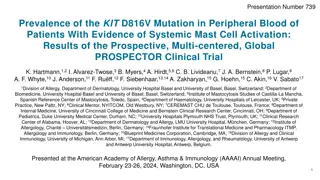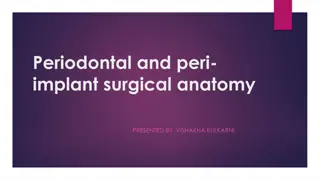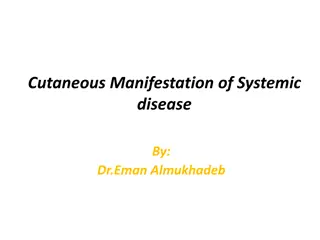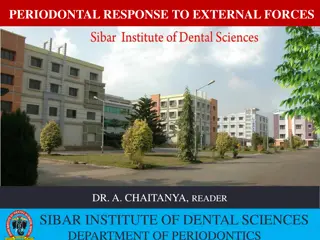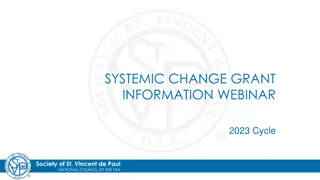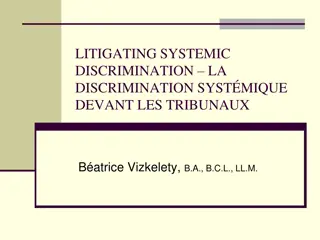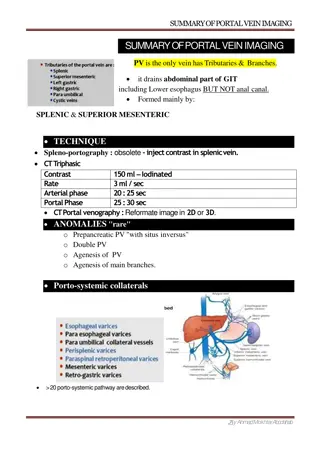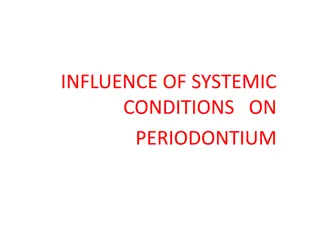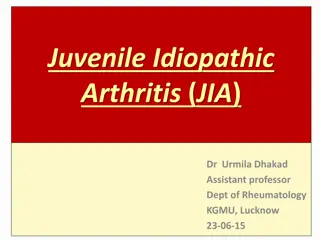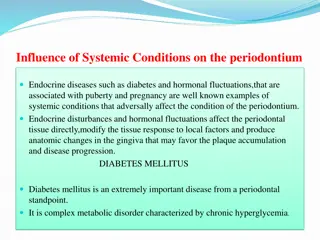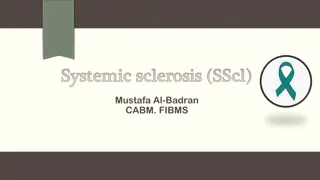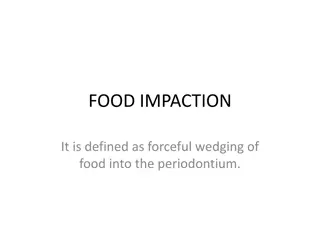Influence of Systemic Conditions on Periodontium
Periodontitis is a chronic bacterial infection affecting teeth's supporting structures. Host responses vary, and systemic conditions can alter tissues and immunity, worsening the disease's severity and progression due to impaired defenses against pathogens. Recognizing these influences and their roles in periodontal disease is crucial, as systemic disorders themselves do not directly cause periodontitis but can predispose or accelerate its development.
Download Presentation

Please find below an Image/Link to download the presentation.
The content on the website is provided AS IS for your information and personal use only. It may not be sold, licensed, or shared on other websites without obtaining consent from the author.If you encounter any issues during the download, it is possible that the publisher has removed the file from their server.
You are allowed to download the files provided on this website for personal or commercial use, subject to the condition that they are used lawfully. All files are the property of their respective owners.
The content on the website is provided AS IS for your information and personal use only. It may not be sold, licensed, or shared on other websites without obtaining consent from the author.
E N D
Presentation Transcript
INFLUENCE OF SYSTEMIC CONDITION ON THE PERIODONTIUM
Learning objectives Systemic conditions impacting periodontitis Endocrine disorders and hormonal changes Hematologic disorders and immune deficiencies Genetic disorders Stress and psychosomatic disorders Nutritional influences Medications
Introduction Periodontitis is a chronic bacterial infection of the supporting structures of the teeth Host response varies between the individuals and an altered deficient response to bacterial pathogens may lead to more severe forms of disease Systemic disorders and conditions alter host tissues and physiology , which may impair hosts barrier function and immune defense against periodontal pathogens creating opportunities for destructive periodontal disease
It is important to recognize that these disorders and conditions themselves do not cause periodontities ,but they may predispose, accelerate or increase its progression.
Various systemic factors that play role in etiology of periodontal disease are as follows : Endocrine disorders Hormonal changes Hematologic disorders Stress and psychosomatic disorders Genetic disorders Immune deficiencies Nutritional influences Other systemic conditions Medications
ENDOCRINE DISORDERS AND HORMONAL CHANGES Endocrine disturbances and hormone fluctuations affect the periodontal tissues directly , modifiy the tissue response to local factors , and produce anatomic changes in the gingiva that may favor plaque accumulation and disease progression.
DIABETES MELLITUS It is a complex metabolic disorder characterized by chronic hyperglycemia It is chronic disease caused by inherited and or acquired deficiency in production of insulin by the pancrease ,or by the ineffectiveness of the insulin produced . Such a deficiency results in increased concentrations of glucose in the blood , which in turn damage many of the body s systems , in particular the blood vessels and nerves.
Oral manifestations ORAL CHANGES IN PATIENTS WITH DIABETES : Cheilosis Mucosal drying and cracking Diminished salivary flow Alterations in the flora of oral cavity Increased rate of dental caries
PERIODONTAL CHANGES IN PATIENTS WITH DIABETES Enlarged gingiva Sessile or pedunculated gingival polyps Polypoid gingival proliferations Abscess formation Periodontitis and loosened teeth
BACTERIAL PATHOGENS The increased glucose in the gingival fluid and blood of diabetic patients could change the enviroment of the microflora ,inducing qualitative chages in bacteria that could contribute to the severity of periodontal disease observed in those with poorly controlled diabetes. Patients with type 1 diabetes mellitus and periodontitis have beenreported to have a subgingival flora composed mainly of capnocytophaga , anaerobic vibrios and actinomyces species
Porphyromonas gingivalis ,prevotella and aggregatibacter actinomycetemcomitans which are common in periodontal lesions of individuals without diabetes are present in low number in those with the disease. Other studies , however found scarce capnocytophaga and abundant A. actinomycetemcomitans and black pigmented bacteroides as well as P. intermedia ,p. melaninogenica and campylobacter . Black pigmented species especially p.gingivalis ,p.intermedia and c. rectus are prominent in severe periodontal lesions of pima indians with type 2 diabetes
EFFECT ON HOST RESPONS POLYMORPHONUCLEAR LEUKOCYTE FUNCTION: The increased susceptibility of diabetic patients to infection has been hypothesized as being caused by polymorphonuclear leukocyte deficiencies resulting in: Impaired chemotaxis Defective phagocytosis Impaired adherance In patient with poorly controlled diabetes the function of PMNs monocytes and macrophages are impaired.
ALTERED COLLAGEN METABOLISM Chronic hyperglycemia adversely affects the synthesis maturation, and maintenance of collagen and extracellular matrix In the hyperglycemic state , numerous proteins and matrix molecules undergo a nonenzymatic glycosylation resulting in AGEs [advanced glycation end product]
Collagen is cross linked by AGE molecules Making it less soluble and less likely to be normally repaired or replaced Cellular migrtion through cross linked collagen is impeded ,and tissue integrity is impaired as a result of damaged collagen remaining in the tissues for longer periods
As a result ,collagen in the tissues of patients with poorly controlled diabetes is older and more susceptible to pathogenic breakdown [i.e less resistant to destruction by periodontal infections]
FEMALE SEX HORMONES Gingival alterations during puberty ,pregnancy and menopause are associated with physiologic hormonal changes in the female patient. During puberty and pregnancy these changes are characterized by nonspecific infammatory reactions with a predominant vascular component, which leads clinically to a marked hemorrhagic tendency. Oral changes during menopause may include thinning of the oral mucosa ,gingival recession xerostomia ,altered taste ,and burning mouth
puberty Occurs between the average ages of 11 to 14 in most women The production of sex hormones increases then remains relatively constant during the remainder of the reproductive phase . Also, the prevalence of gingivitis increases ,without an increase in the amount of plaque
Clinical features During puberty periodontal tissues may have an exaggerated response to local factors . A hyperplastic reaction of gingiva may occur in areas where food debris ,materia alba ,plaque , and calculus are deposited . The inflammed tissue become erythematous ,lobulated ,and retractable
Bleeding my occur easily with mechanical debridement of the gingival tissues .
Menses During menses ,progesteron increases from the second week , peeks at approximately 10 days , and dramatically drops before menstruation Prevalence of gingivitis increases. Gingival tissues have been reported to be more edematous during menses and erythematous before the onset of menses in some women
Complains of bleeding gums . bloated or tense feelingin the gums preceding menstrual flow . Increased exudation from inflamed gingiva suggesting that pre-existing gingivitis in aggravated but GCF of normal gingiva not affected .
Pregnancy Pregnant women ,near or at term ,produce large quantities of estradiol ,estriol and progesterone . Gingival inflammation initiated by plaque ,and exacerbated by these hormonal changes in the second and third trimester of pregnancy ,is referred to as pregnancy gingivitis .
Periodontal manifestations Pregnancy itself does not cause gingivitis . Gingivitis in pregnancy is caused by bacterial plaque ,just as it in non pregnant women . Pronounced ease of bleeding is most striking clinical feature . Gingiva is inflamed and varies in color from a bright red to bluish red .
Marginal and interdental gingiva are edematous ,pit on pressure ,appear smooth shiny ,are soft and pliable and sometimes present a rasberry lip appearance . Extreame redness result from marked vascularity ,and there is an increased tendency to bleed . Gingival changes are usually painless unless complicated by acute infection
HEMATOLOGIC DISORDERS AND IMMUNE DEFICIENCIES WBCs : involved in the inflammatory reactions. RBCs : responsible for gas exchange and nutrient supply to the periodontal tissues . Platelets : normal haemostatic as well as recruitment of cells during inflammation and wound healing . Disorders of any blood cells or blood forming organs have profound effect on periodontium .
LEUKOCYTE [NEUTROPHIL] DISORDERS NEUTROPENIA : Neutropenia is a blood disorder that results in low levels of circulating neutrophils . Serious condition caused by diseases ,medications ,chemical ,infections, idiopathic conditions or hereditary disorders . May be chronic or cyclic ,severe or benign . Mild neutropenia : ANC of 1000-1500 cells/micro.lit Moderate : ANC of 500 -1000 cells /micro. Lit Severe : ANC less than 500 cells /micro.lit
AGRANULOCYTOSIS It is characterized by a reduction in the number of circulating granulocytes and results in severe infections, including ulcerative necrotizing lesions of the oral mucosa ,skin and gastrointestinal and genitourinary tracts . Less severe form of the disease are called neutropenia or granulocytopenia . Drug idiosyncrasy is the most common cause of agranulocytosis ,but in some cases,its cause cannot be explained
The onset of disease is accompanied by fever ,malaise, general weekness, and sore throat. Ulceration in the oral cavity, oropharynx,and throat is characteristic. The mucosa exhibits isolated necrotic patches that are black and grey and are sharply demarcated from adjacent uninvolved areas . The absence of a notable inflammatory reaction caused by lack of granulocytes is a striking feature.
LEUKAEMIA The leukemias are malignant neoplasias of WBC precursors , characterized by : 1] diffuse replacement of the bone marrow with proliferating leukemic cells . 2]abnormal numbers and forms of immature WBCs in the circulating blood 3] widespread infiltrates in the liver ,spleen, lymph nodes,and sites throughout the body.
CLASSIFICATION According to the type of WBC involved 1. lymphocytic 2 .Myelocytic or myelogenous According to their evolution 1 . Acute 2. Subacute 3 . Chronic
All leukemias tend to displace normal components of bone marrow elements with leukemic cells Resulting in reduced production of WBCs RBCs Platelets Results in poorer tissue oxygenation making tissues more friable and susceptible to breakdown Leads to an increased susceptibility to infections Leads to bleeding tendency which can occur in any tissue
Periodontium in leukemic patients Oral and periodontal manifestations of leukemia consist of : Oral Leukemic infiltration ulcerations and infections Bleeding Gingival enargement
Leukemic infiltration Leukemic cells can infiltrate the gingiva and , less frequently ,the alveolar bone . Gingival infiltration often results in leukaemic gingival enlargement . It may be to the interdental papillae area or it may expand to include the marginal gingiva and partially cover the crowns of the teeth .
Leukemic infiltration causing localized gingival swelling of the interdental papillae between the maxillary central incisor and lateral incisor
Leukemic cells can infiltrate the gingiva and less frequently the alveolar bone . Gingival infiltration often results in leukemic gingival enlargement. The abnormal accumulation of leukaemic cells in dermal and subcutaneous CT is called leukaemia cutis and forms elevated and flat macules and papules .
Gingiva appears initially bluish red and cyanotic with a rounding and tensesness of the gingival margin ; then it increases in size most often in the interdental papilla and partially covering the crowns of the teeth .
Genetic disorders Many systemic conditions associated with or predisposing to periodontal destruction include genetic disorders that result in an inadequate number or function of circulating neutrophils. Severe periodontitis has been observed in individuals with primary neutrophil disorders such as neutropenia, agranulocytosis , chediak-higashi syndrome and lazy leukocyte syndrome.
In addition , severe periodntitis has also been observed inindividuals who exhibit secondary neutrophil impairment as seen in down syndrome ,and inflammatory bowel disease .
Stress and psychosomatic disorders Stress and psychosomatic disorders most likely impact the periodontal health through changes in the individual s behaviour and through complex interactions among the nervous ,endocrine and immune systems Individuals under stress may have poorer oral hygiene , may start or increase clenching and grinding of their teeth and may smoke frequently
Nutrition and periodontal disease There are no nutritional deficiencies that by themselves can cause gingivitis or periodontitis however ,nutritional deficiencies can affect the condition of the periodontium and therby may accentuate the deleterious effect of plaque induced inflammation in susceptible individuals . There are nutritional deficiencies that produce changes in the oral cavity .these changes include alteration of the tissues of the lips ,oral mucosa ,gingiva and bone


